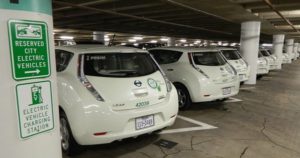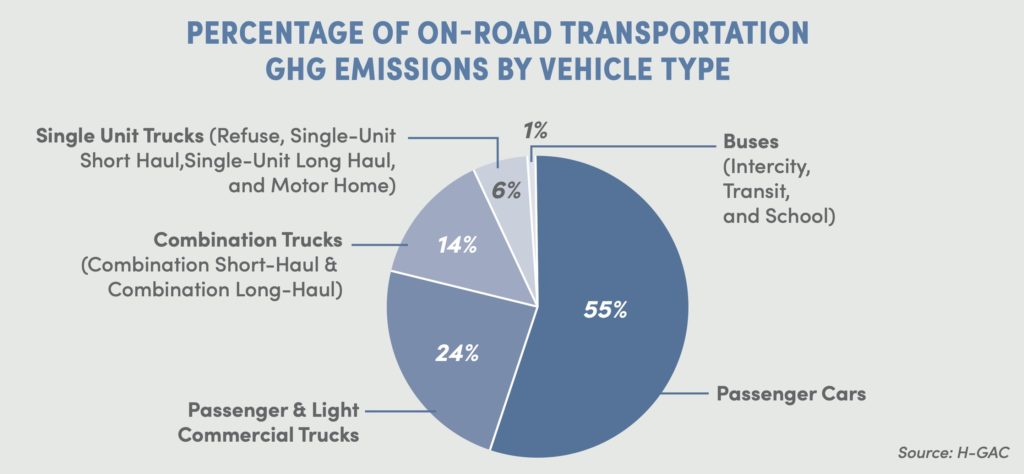Houston’s Electric Vehicle Fleet Plans are Good News for Climate
Largest Texas city should strive to meet ambitious goals
By Stephanie Thomas
 Mayor Sylvester Turner announced the City of Houston’s Climate Action Plan on the 50th Anniversary of Earth Day in April 2020. In this blog we look at one of the four major themes of the Houston Climate Action Plan and discuss what the city is doing – and what more can be done – to significantly reduce the Houston area’s transportation pollution.
Mayor Sylvester Turner announced the City of Houston’s Climate Action Plan on the 50th Anniversary of Earth Day in April 2020. In this blog we look at one of the four major themes of the Houston Climate Action Plan and discuss what the city is doing – and what more can be done – to significantly reduce the Houston area’s transportation pollution.
Transportation’s Role in Climate Crisis
Most cars, pickups, and heavy duty trucks burn petroleum-based fuel for power, releasing greenhouse gases like carbon dioxide, as well as other harmful air pollutants like NOx (nitrogen oxides), particulate matter and benzene, into the atmosphere.
According to the Environmental Protection Agency (EPA), transportation-related greenhouse gas emissions account for about 29% of the US’s total greenhouse gas emissions. Over the last 30 years, emissions from the transportation sector grew more than any other sector.
The 2014 Baseline Greenhouse Gas Emissions Inventory created by the City of Houston as part of the Climate Action Plan analyzed emissions from three major sectors: buildings (including electricity use), transportation, and waste. Transportation represented 47% of emissions in the Houston area, with a total annual emissions of over 16 million tons of greenhouse gases each year. That’s more than 5 times the weight of all the elephants currently living on Earth!

The city’s emissions inventory also calculated that vehicles travel over 33 billion miles altogether each year within the city. That’s the same amount of mileage that a spaceship would travel going back and forth between Earth and the Sun 177 times (if the spaceship wouldn’t melt)!

Transportation clearly plays a major role in exacerbating the climate crisis. But you can also think of it this way: reducing transportation emissions benefits the climate. How do we accomplish that? By taking cars off the road and making public transit, walking, and biking safe and accessible to all. Replacing vehicles with those using cleaner fuel sources, such as battery-powered electric, will also reduce emissions.
How is Houston Committing to Reducing Transportation Emissions?
Houston’s Climate Action Plan sets out three goals: (1) shift the regional fleet (the vehicles traveling through and within City of Houston) to electric and low-emission vehicles, (2) reduce vehicle miles traveled (VMT) per capita, and (3) provide equitable and safe mobility choices. It commits the City to converting its non-emergency, light-duty municipal fleet to 100% EV by 2030, as well as reducing vehicle miles traveled by 20% by 2050. The plan also establishes safety as a priority, aiming to eliminate traffic-related fatalities and serious injuries on Houston streets. As part of the plan, 500 miles of high-comfort bike lanes (meaning both adults and children can use them safely) will be created by 2025.
No doubt, these are ambitious goals and targets set by the City of Houston. Ensuring that they’re met requires serious, sweeping and concerted action.
How is the City Enacting its Climate Action Plan with Regard to Transportation?
Two big announcements related to the Climate Action Plan’s transportation goals peppered the headlines this year.
In July, METRO announced that it will be moving its bus fleet toward electric buses by 2030. At present, Port Arthur and Odessa have more electric buses than METRO, the transit authority for the Houston Metro area.
In September, the City of Houston’s Fleet Manager Gary Glasscock presented a plan to convert non-emergency city vehicles to 100% electric vehicles to the City Council’s transportation committee. To meet this goal, the City intends to acquire 100 new electric vehicles in FY 2022 and will continue to buy more EVs each year until 2030.
Prior to adoption of the Climate Action Plan, Houston was among the top US municipalities in the use of electric vehicles. Unfortunately, in 2017 Hurricane Harvey flooded a number of cars and trucks – including the City’s EV fleet. Currently, the City has 40 EVs and 10 EV charging stations located downtown.
stations located downtown.
In addition to purchasing light duty non-emergency electric vehicles, the City plans to purchase heavy duty electric vehicles, such as waste trucks, as well as supply equipment including chargers and facility modifications.
EVs Will Save the City Money
A recent study by EVolve Houston found that more than 4,000 of the city’s vehicles can be replaced immediately by an EV, and of those, over 1300 could be replaced immediately and affordably. In fact, replacing those 1,345 vehicles would achieve a savings of $6.9 million for the CIty and reduce 2,810 metric tons of carbon dioxide. This is a great first step for the City in meeting its climate action goals.
What More Can Be Done?
Last month, I joined advocates and other community members in delivering public comments to the Transportation Policy Council, a body composed of elected officials and other governmental representatives who make decisions on our region’s transportation planning. The Transportation Policy Council is part of the Houston-Galveston Area Council, which serves as our region’s Metropolitan Planning Organization (MPO). An MPO represents urban areas with populations over 50,000 people to deliver transportation projects using, in part, federal funds. The Houston-Galveston Area represents a total of 13 counties in the greater Houston Metropolitan area.
Every MPO is required to complete a Regional Transportation Plan, which provides guidance on maintaining and improving the current transportation system (roadways, freight, transit, etc.) and identifying priorities for investment for the next 25 years.
The Houston-Galveston Area Council and its Transportation Policy Council have largely avoided discussions of climate change and incorporation of its impacts into the Regional Transportation Plan. This is evident in the Council’s bullish push for the North Houston Highway Improvement Project, known informally as the I-45 expansion.
This boondoggle aims to reduce congestion but highway expansions never accomplish that goal. Ultimately, this project will increase vehicle miles traveled rather than reduce them as set out in the Climate Action Plan.
The Houston-Galveston Area Council has begun working on its 2050 Regional Transportation Plan. Public Citizen is calling on the Transportation Policy Council and the Houston-Galveston Area Council to consider climate impacts as a core tenet of its plan. You can read my comments here.
How the H-GAC Needs to Act on Climate
The Intergovernmental Panel of Climate Change calls our current climate situation “a code red for humanity. Yet we can still take action to reduce our emissions and create a sustainable and resilient region. Taking the necessary steps at all levels of government will help move us along that path.
Both the City of Houston’s Resilience Plan and Climate Action Plan are guiding documents that can help steer the Houston area toward reducing climate-harming emissions and help prepare it for living with a “new normal.” Harris County is currently looking into how it can work to promote climate justice. We need the Houston-Galveston Area Council to do the same by committing to integrating climate into its planning, evaluation, and funding through the 2050 Regional Transportation Plan.
Stephanie Thomas, Ph.D., is a Houston-based researcher and organizer in Public Citizen’s Texas office.